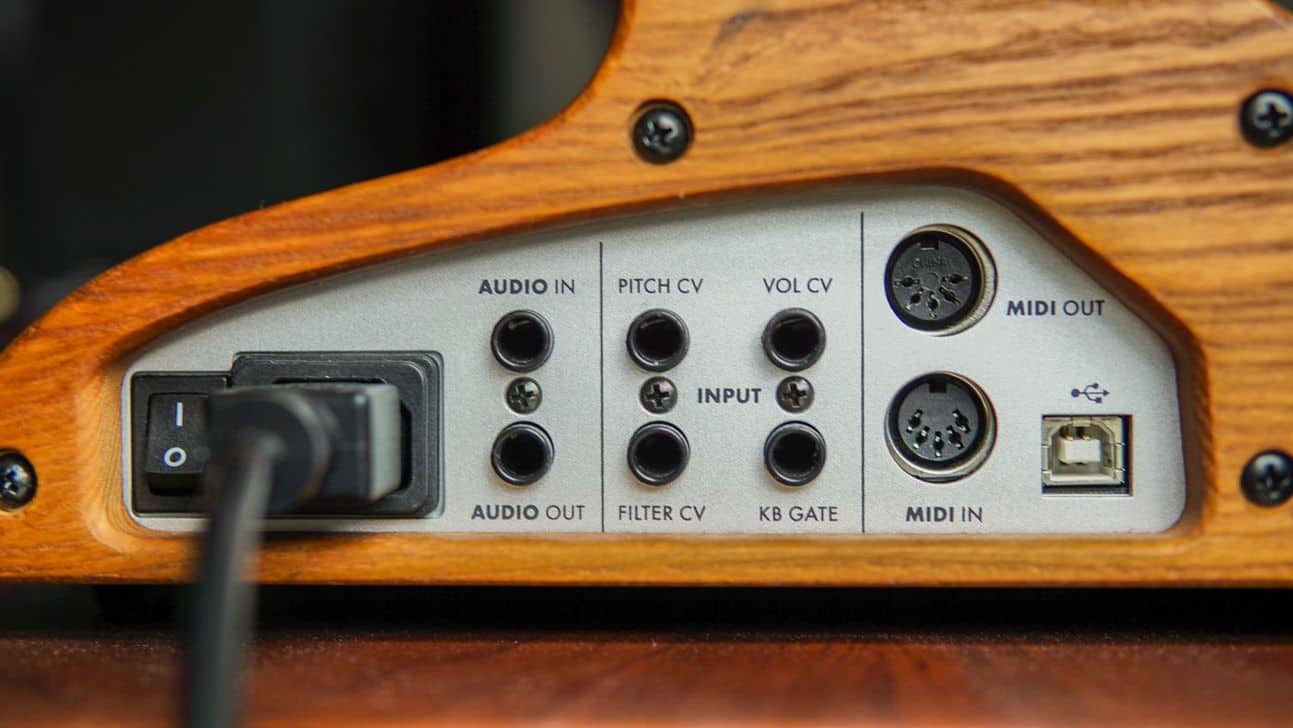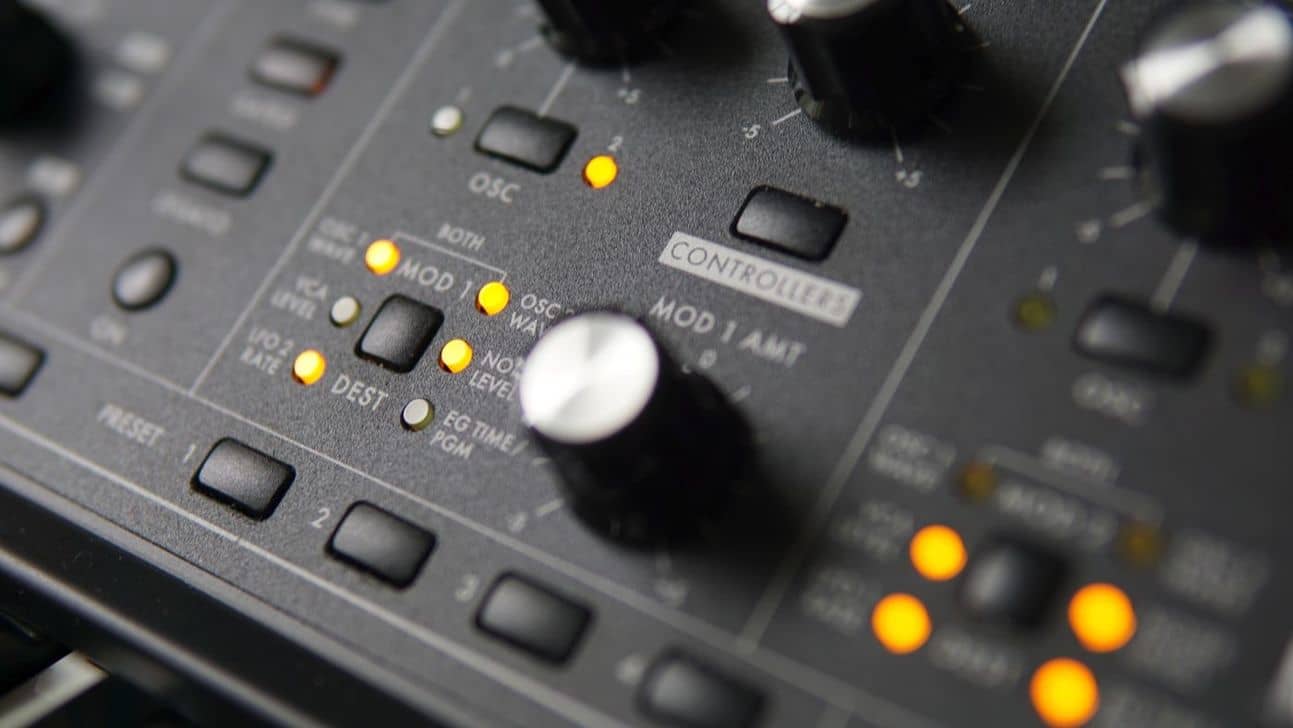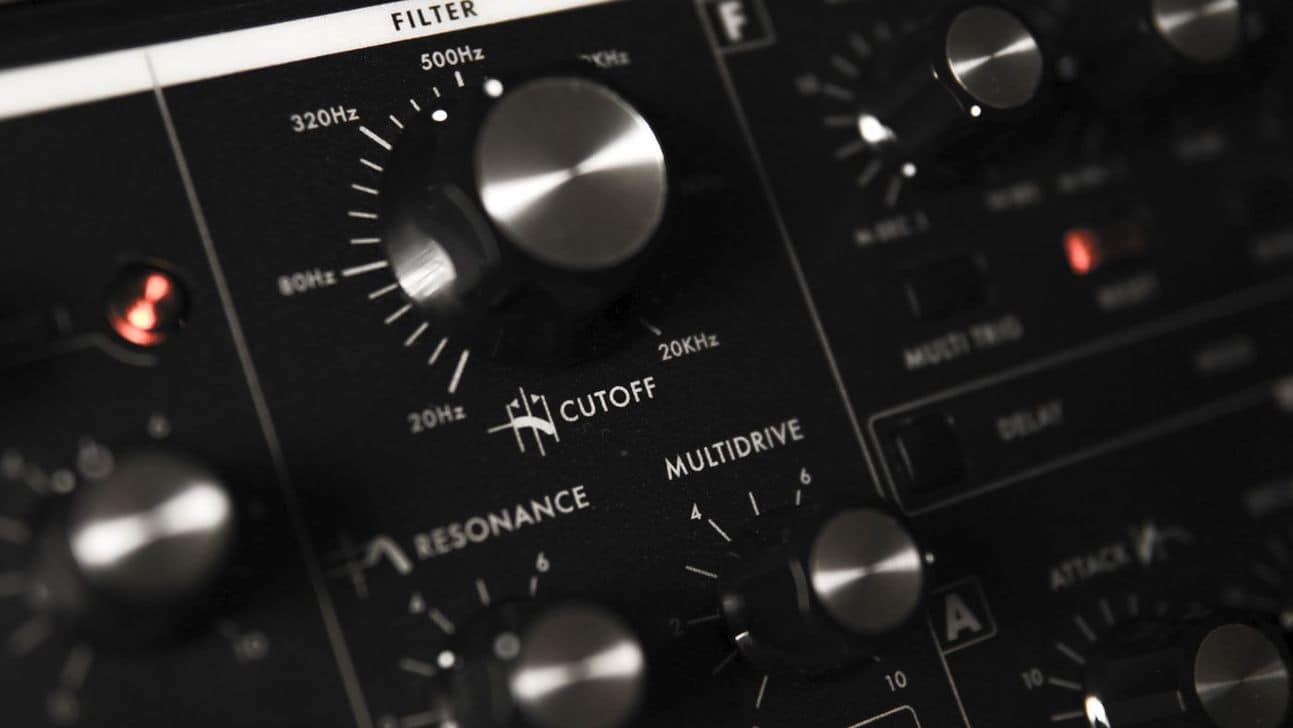If you’re into synthesizers of any kind, it probably didn’t take long before you came across the Moog brand. They are famous for a number of things, such as the theremin, Minifooger guitar pedals and of course their synths. For many, Moog’s legendary Minimoog Model D is considered the absolute standard of a great analog synthesizer. Well over a decade ago, the company returned to the hardware synth scene with the Voyager, and have been coming up with exciting new designs ever since. In this review we’ll be looking at one of their latest, the Moog Sub 37 Tribute Edition synthesizer.
The Sub 37 Tribute Edition is a 37-key paraphonic analog synth, offering two oscillators, a sub oscillator, white noise generator, a switchable-pole low-pass filter with multi-drive, two high speed LFOs, and two DAHDSR envelopes with loop and sync capabilities. It also includes an arpeggiator and a 64-step sequencer. In this case, the term paraphonic means that the Oscillator 2 can be played in real time independently from Oscillator 1, whereas both oscillators share the same filter.
Look & Feel
I’ve been interested in the Sub 37 for a while, after having some brief encounters with the Moog Voyager, Little Phatty and Sub Phatty, all of which I liked very much. The Sub 37 is arguably the most advanced in the company’s range at the moment, barring perhaps even the Voyager XL, although they do have quite different feature sets.
The Sub 37 immediately made a strong positive impression on me. The attention to detail and the craftsmanship were obvious right from the moment I opened the box and laid my eyes on it. The packaging is adorned with a quote from Mr Moog himself, whereas the opposite side of the the packing shows the user guide printed in a large, easily readable font. A bit unusual, but undeniably useful.
The synth is heavy and feels quite solid (no surprises there). The left-side panel houses all the inputs and outputs: the power supply input, Audio In and Out, CV inputs (Pitch, Filter, Volume and Gate) Midi IN/OUT (OUT can be configured to THRU), and USB. The USB transmits and receives MIDI (not audio) and also allows for direct control via the downloadable software editor (see the Sub 37 Editor section below for more info). You may have noticed the lack of a CV output, which is a bit of a shame considering that the sequencer, as we’ll see later, is very capable.
The controls feel smooth and solidly attached. There are indeed a ton of them, organized logically across the front panel. There are 40 knobs and 74 switches in total, according to the manual I didn’t count them all, but I think I’ll take Moog’s word for it! The keys are semi-weighted and velocity sensitive with aftertouch. They feel great. The mod and pitch wheels have good weight and spring respectively. The manual is well written and includes a nice and concise introduction to synthesis, covering the fundamentals of building synth sounds.
The majority of the controls you’ll be using most often are laid out on the front panel, whereas the rest are easily accessible in the menu, making the user interface quite transparent. Parameters like oscillator reset, LFO speed (high or low) or filter pole selection are typically the sort of controls I’d expect to find hidden in the menu, but these are all given their own buttons on the front panel, too.
This immediate access to even the more “advanced” parameters is one clear difference between the Sub 37 and the Sub Phatty. As another good example of Sub 37’s ease of use, all you need to do in order to assign a destination to an LFO is to hold down the “MOD DEST” control and move the knob or push the button you want to modulate and, presto, it’s done! There’s also an initialize button (yes!) which will immediately switch the selected preset slot back to an initialized state.
Things do get a little more complicated with some of the sequencer functions, but most of what you’ll be editing is directly laid out on the front panel, with sixteen LED diodes running along the bottom row letting you know where you are within a sequence. This row of illuminated buttons also serves as a shortcut to access the presets in a loaded bank, so naturally the banks contain sixteen presets each.
The LCD display is rather minimal in terms of available information, but still effective. I’ve become accustomed to seeing parameter readouts on a synth’s screen, however this feature is not offered on the Sub 37. It’s not so much that I need this function, but I kept looking at the display expecting to see exact parameter readouts. This is more out of habit than any real need for the readout, and I did adjust to it soon enough.
A Closer Look
So far I’ve given you a quick overview of the Sub 37 and its features. Let’s zoom in a little and get down to the individual parts that make up the whole, starting with the oscillators. These are continuously variable from a triangle waveform to a skinny pulse wave, although you can actually make the pulse thin out to complete silence via modulation. Oscillator 2 can be hard-synced to Oscillator 1 and both oscillators can be set to “Phase reset” mode with a single button.
As I mentioned earlier, the “Duo-mode” allows you to play 2-note chords, whereas both oscillators will share the same filter. You can also turn off keyboard tracking for Oscillator 2 and use it as a drone. There is a single sub-oscillator on offer, always set to square wave and one octave below Oscillator 1. This really can’t be modulated in any way, apart from it following pitch modulation applied to its master OSC. The Sub 37 also features a white noise generator that is controlled by a single knob within the mixer section.
The envelopes feature Delay, Attack, Hold, Decay, Sustain and Release phases. They can be latched on for continuous sounds and also feature a “Loop” mode, which allows the envelopes to be used as an LFO of sorts. In addition, the envelopes can also be synced to re-trigger according to tempo. I’m quite happy to say that the envelopes are very fast and precise, producing clear and defined transients. By taking advantage of the sync and loop/repeat modes, they can be used to produce some great rhythmic effects.
The envelopes themselves are actually digital, as are the LFOs. Digital modulators have a bit of a reputation for being slower than their analog counterparts, however this is a preconception that dates back to the earlier days of hybrid synthesis when some older analog synthesizers that used digital envelopes and LFOs had poor speed performance. The Sub 37 suffers from none of these problems. The low frequency oscillators are extremely fast, with a range from 0.01Hz to 1000Hz and my ears don’t detect any “bottleneck” with the modulation bus here. By the way, the LFOs can also produce noise and sine waves which can be synced to tempo, reset per note, and even set to follow a swing timing!
The mixer section is nicely laid out and it includes mute buttons for each element. These controls are very useful in live performance scenarios, as you can quickly switch sections in and out. There is a lot of play here as unity gain is half way, so anything over this way will begin to drive the filter section. By backing off the mixer controls, you can get a very clean sound. Do it the other way around and you’ll get a beefier and more aggressive sound. The filter also has a multi-drive control which drives an OTA and JFET stage, giving you a wide range of saturation flavors to choose from. This allows for some drastic character changes and is probably my favorite special feature on this synth. Keep in mind that you can run external signals through this section and use the Sub 37 for adding some genuine analog spice to your audio!
The classic sound of the Moog filter just doesn’t get old to me and the filter section on the Sub 37 does not disappoint. You can switch between multiple pole settings, offering 6dB, 12dB, 18dB and 24dB roll-offs. The 24dB filter is still my favorite, but the new pole options bring some welcome additional flavors to the table. In particular, the 6dB filter combined with multi-drive yields some amazing acid sounds. Speaking of acid, there are three types of glide available too: constant rate, time and exponential.
As I mentioned before, the Sub 37 is a paraphonic synthesizer. A first for Moog, I believe. I knew right away that this feature will be a big plus, as it’s great to be able to play the second oscillator on top (or underneath) the first one. Duo-mode also lets you unleash the full potential of all the varieties of distortion available, from a subtly clipped filter to outright madness with the multi-drive at full whack. Different note intervals played with these overdrive settings can produce some seriously moody growling and breathing and it just makes the synth sound organic and alive.
One of the star features of the Sub 37 is its new sequencer. It is easy to use and quite powerful at the same time. Up to 64 steps are available with ratchet and tie per-step and duophonic capability. There are also two modulation values which can be assigned per-step, whereas their destinations are accessible via the menu and, of course, the software editor. Furthermore, switching between presets that have active sequences is seamless, so you can easily string different sequenced patches together. You can set the sequence length, skip steps directly by switching them on or off via the front panel, and even rotate the sequence.
The Sound
I always thought of Moog synths as something you’d buy if you’re going for that well known “Moog sound”, but I ended up being surprised by just how versatile the Sub 37 is. The Moog character that I’ve become accustomed to is definitely there, but it’s very malleable. The multi-drive feature provides a glimpse of what the future Moog sound might become. The most pleasing thing about Sub 37’s sound for me, though, was how well it worked in my mixes. I’d describe the synth’s sound as rich and musical, slightly on the darker side, but not murky or muffled by any means. It’s classy. The mixer doesn’t bleed through, there is very little noise that I could detect, and the output level is healthy.
See also: Arturia MicroBrute ReviewIt tunes up immediately and it remains stable even after hours of use. The tuning is certainly tightly controlled, but there is actually a “Pitch Variance” control which will detune the oscillators by random amounts if you want to make the Sub 37 sound more vintage. You can make this effect as subtle or as extreme as you like!
Almost every kind of sound I programmed with this synthesizer came out sounding great, in fact even better than I expected. The Sub 37 was able to deliver an addictive analog quality that doesn’t fatigue the ear, while being rich and complex at the same time.
Caveats
But it can’t be all roses, surely? After quite a bit of thought, I came up with a couple of potential issues. Firstly, It wasn’t until I took the unit out of the box and set it on my keyboard stand that I realized just how big the Sub 37 is. It measures 6.75″H x 26.75”W x 14.75”D, which could definitely pose a problem if you’re tight on space, especially if you intend to place it on your desk.
The next issue is more of a cosmetic nature. The front panel is covered in a polycarbonate overlay which has all the labels and markings printed on it. The problem is, it looks like this overlay was glued on, which isn’t an issue in itself at all, but the glue which seeps out from some of the holes makes these little areas prone to collecting dust and other muck. And because the glue is so sticky, it’s also quite difficult to clean. It’s a minor thing really, but it might bother you if you’ve got a tendency of wanting to keep your gear immaculate. Just saying!
Software Editor
To use the pre-release version of the Editor, I had to update my Sub 37’s firmware first. The firmware update app would not open on my OS (OSX 10.10.5), but fortunately SysEx files were included so I could update the firmware manually. Since then, the first stable version has gone public, so your experience may vary.
I’ve updated synth firmwares before and, as far as I can remember, I’ve not come across a more helpful installation guide than this one. Moog even included a very good recommendation for what app I could use on the Mac to send the SysEx files. The procedure itself was a bit complicated, and my first attempt appeared to fail, but the guide let me know what to do at any given stage of the process. So I tried it again from the beginning and a few Honest Trailers later, the update was complete. It was time to check out the Software editor.
Running the software for the first time required me to wait for around a minute for the patches to sync, as the editor grabbed them from the Sub 37 hardware. The Editor has a good sized GUI and it’s very nicely designed. Loading up the editor is a great way to learn what the Sub 37 is capable of, since you have every single control parameter laid out in front of you. This is particularly useful for playing around with the sequencer.
The Verdict
I remain deeply impressed with the Sub 37, and Moog generally. They make the Sub 37 synths entirely in the USA, using locally sourced materials for the steel/wood elements and the analog board. The synthesizer itself is chock-full of meaningful and usable features, all for $1,500 street. Sure, there are cheaper synths out there, and good ones at that, but when you take into account everything being offered here, it’s fantastic value for money.
I wholeheartedly recommend it to newcomers and advanced synth programmer alike. The Sub 37 sounds fantastic and it provides enough complexity to keep you busy for a long time. I hate writing glowing reviews, everything has flaws, but this one time I just have to hope the reader will trust my integrity. Yes, there are some (very minor) niggles and I’m not saying this synth will be a perfect choice for everyone, but if you’re in the market for an analog synth in this price range, I couldn’t think of a single reason not to recommend the Sub 37!
More info: Moog Sub 37 (Moog Music website)
Moog Sub 37 Review
Moog Sub 37 sounds fantastic and it provides enough complexity to keep you busy for a long time. If you’re in the market for an analog synth in this price range, we couldn't recommend this wonderful instrument highly enough.
-
Sound10
-
Versatility9
-
Build Quality9
-
Design10
-
Pricing9







2 Comments
Esol
onSeems like a great synth, but Moog is an expensive brand. But I guess it’ll be a good investment. Ive seen Sonicstate review this, and it sounds great.
Sean
onThanks for writing such a comprehensive review! I’ll be buying my Sub 37 very soon.